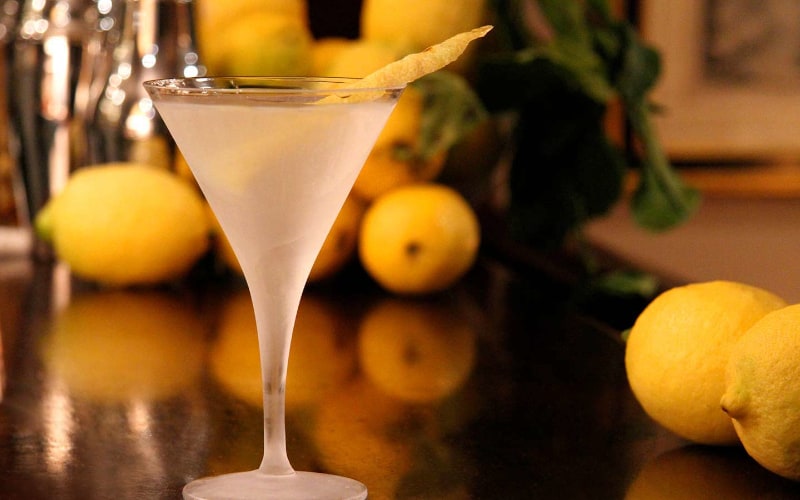During a recent trip to London, I happened to hear that Dukes Hotel, a small boutique establishment tucked in a quiet cul de sac off St. James’s Street, served the best martini in the world. Now, being a serious student of British history and tradition, I felt beholden to delve a bit deeper. Wine is my usual libation, so I confess that I am not a connoisseur of cocktails. However, I was very willing to get into the spirits of things.
For anyone who loves history, walking into the Dukes Bar is in itself an intoxicating seduction of the senses. The two sitting rooms are intimate in scale, with plush carpeting, creamy wood trim and muted lighting that creates the feeling that you’re stepping into the private parlor of a friend—a very posh friend. One with oodles of taste and oodles of Old Money. Painting and prints of historic dukes adorn the pale taupe walls, their regal visages presiding over the well-heeled crowd. Wellington. Devonshire. York . . .
And then there’s Alessandro. The Duke of the Drinks trolley, he is resplendent in his elegant white dinner jacket and dapper black tie. His voice is low and liquid, and somehow I feel impossibly chic as I take a seat in one of the soft leather chairs, imagining myself swathed in silk, satin and pearls. When he hears that I know precious little about his specialty of the house, he smiles and offers to educate me.
But first, a bit of history on gin, which according to Alessandro is the preferred spirit for a true martini. (He gives a long suffering sigh at the mention of vodka—though Ian Fleming was a regular at Duke’s, Alessandro claims he enjoyed “shaking things up” and so made James Bond a bit of a rebel with his vodka martini.)
Gin, which derives from the Dutch word genever, is a grain-based spirit infused with juniper, and is said to have originated in Holland sometime during the early 17th century. (Though some claim it was prevalent in Renaissance Italy.) During the Thirty Years’ War, English soldiers picked up the habit of indulging in a little “Dutch Courage” before battle, and when they returned home, they brought with them a taste for gin.
William of Orange, who came to the English throne in 1689 after the “Glorious Revolution,” encouraged its consumption, as he wished to discourage the import of brandy and other spirits from Catholic countries such as France. The drink became popular—a little too popular. By the 1730s, drunkenness among the poor was a huge problem, as depicted by Hogarth is his print “Gin Lane.” Of the 15,000 drinking establishments in London, over half were said to be gin shops. (Gin, which requires no aging, is a relatively cheap liquor to produce.) Some pubs had a plaque shaped like a cat on its outside walls. Known as ‘Old Tom,’ this contraption served as a precursor of the modern vending machine—a person would insert a penny into the cat’s mouth and place his mouth around a tube between the paws. In return, the barkeeper would pour a shot of gin through the tube. ‘Old Tom’ gin is a style that still exists today, and like many 19th century gins, is sweeter than other modern blends.
The government passed a Gin Act in 1739, which failed to control the trade and ended up being repealed in 1742. To circumvent taxes, many makers called their spirits “medicinal” draughts and marketed them with such names as Cuckold’s Comfort and My Lady’s Eye Water. In the 1750s, the government did manage to regulate the production and distribution somewhat, but gin remained a drink of the lower classes. However, with the advent of new distilling techniques in the mid 1800s, gin became a lighter, more refined spirit—known as ‘London Dry’—and became popular with the ladies in Victorian times.
As the British Empire spread around the globe, gin went with it. It became a favorite drink in places like India, where it was mixed with quinine “tonic’ water—an anti-malarial botanical—to mask its bitter taste. In America, gin’s low cost and ease of production made it a staple of the Prohibition era. Along with whiskey and rye, it’s cleaned up its image considerably since then and today, of course, it’s a basic ingredient in countless cocktails.
‘London Dry’ is the most common style of gin. There is also ‘Plymouth’ gin, which is a full-bodied blend flavored with citrus peel, orris and angelica root, cardamom and coriander, as well as juniper. (Only one distillery, Coates & Company, is allowed to call itself ‘Plymouth’ gin.)
Now back to Alessandro. He decided to make me a ‘classic” martini, for which he chose Plymouth gin. Rolling over his vintage wood and brass drink cart, he uncapped a bottle fresh from the freezer—that’s part of his secret for making the perfect martini. A spritz from an atomizer is all the vermouth he adds to the glass—which is also frozen. (Churchill, who took his drinks seriously, is said to have remarked that merely waving a vermouth cork over the gin was enough.)
He proceeded to cut a long strip of lemon peel—a bit over two inches—which he carefully pinched, skin side to skin side, over the drink to release the oils over the surface. Then he rubbed the peel along the rim, and gently placed it in the gin. As the glass warms, he told me, the essence of the lemon oil would slowly infuse the drink. “It’s really quite simple,” he remarked.
Simple but sublime.
I may never become a regular martini drinker, but I smile knowing that I’ve tasted the best in the world. Thank you, Alessandro.

